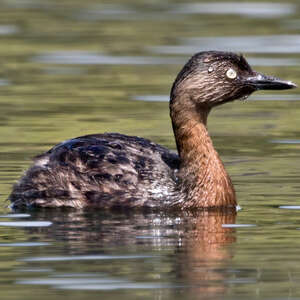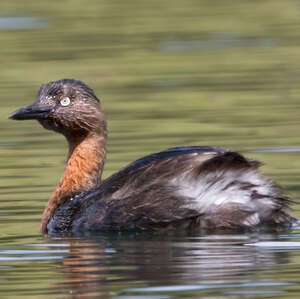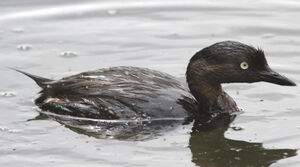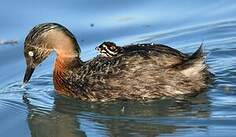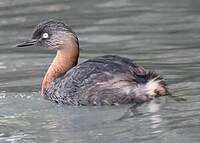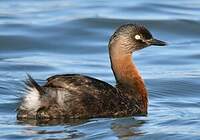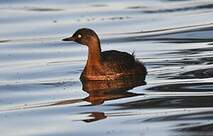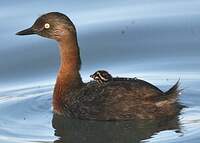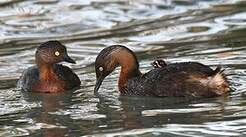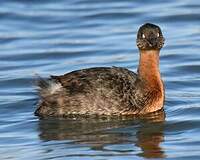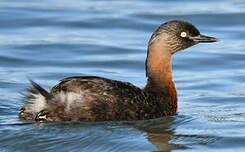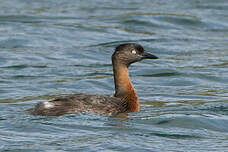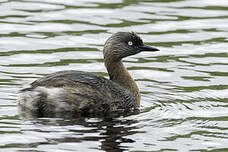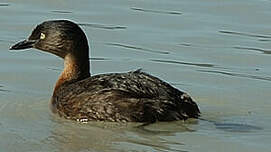New Zealand Grebe
Poliocephalus rufopectus - Grèbe de Nouvelle-Zélande
Identification
The New Zealand Grebe is a small waterbird that resembles the Black-necked Grebe or Slavonian Grebe. Its neck is thin and reddish-brown. Its head is small and its bill appears slightly upturned. Its overall appearance is dark and without much contrast. In breeding plumage the head is gray and the body is brown. In immature or non-breeding plumage it is entirely brown. When in flight or preening its wings, which are easily visible, are white (coverts) and black (remiges).
Subspecific information monotypic species
Foreign names
- Grèbe de Nouvelle-Zélande,
- Zampullín maorí,
- mergulhão-neozelandês,
- Maoritaucher,
- maori vöcsök,
- Nieuw-Zeelandse Fuut,
- Svasso di Nuova Zelanda,
- maoridopping,
- Maoridykker,
- potápka maorská,
- potápka novozélandská,
- Newzealandsk Lappedykker,
- uudenseelanninuikku,
- cabussó de Nova Zelanda,
- perkoz maoryski,
- Новозеландская поганка,
- ニュージーランドカイツブリ,
- 新西兰䴙䴘,
- 紐西蘭鸊鷈,
Habitat
The New Zealand Grebe prefers shallow and sheltered waters such as dune reservoirs or small bays and backwaters of large lakes. However, it has colonized artificial reservoirs in agricultural regions. It can also be found, in winter, in lagoon sewage treatment plants. The presence of reeds is not necessary.
Behaviour character trait
The individuals we observed in New Zealand did not seem very shy. As with most small grebes, this species often dives.
These dives can be done either abruptly, with the bird making a small hop forward to plunge, or calmly, gradually submerging itself. In case of danger, it calmly moves away swimming either on the surface or underneath the water. If the danger is more substantial, it quickly flees, running on the surface of the water with the help of its wings.The species seems to be sedentary.
Dietfeeding habits
Reproduction nesting
Threats - protection
IUCN conservation status
concern
in the Wild
threatened
evaluated
Once widespread on the fresh waters of the two main islands of the country, the New Zealand Grebe has disappeared from the South Island in the 1940s. The population of this endemic species is now no more than around 1800 individuals. Couples nesting on the edges of large lakes have a low reproduction success, which could likely be explained by the numerous disturbances it suffers due to the development of all kinds of water leisure activities. Poor weather conditions also cause the loss of many nests. The success is better in small, duney lakes and agricultural reservoirs. Predation also plays a significant role, with the main predators being introduced rats and Mustelidés. The recent (but natural) installation of the Australasian Grebe (Tachybaptus novaehollandiae) may be a new threat. The species is now classified as vulnerable by BirdLife International, while it was still considered 'endangered' a few years ago. This repositioning is due to the fact that the population seems to have stabilized and viable populations (several hundred couples) exist in some large lakes.
Sources of information
- IOC World Bird List (v14.1), Gill, F and D Donsker (Eds). 2024-04-18.
Other sources of interest
 Specification sheet created on
04/08/2023 by Georges Olioso
Specification sheet created on
04/08/2023 by Georges OliosoTranslation by AI Oiseaux.net
published: 26-05-2006 - Updated: 25-05-2006
© 1996-2024 Oiseaux.net
- Accipitriformes
- Aegotheliformes
- Anseriformes
- Apodiformes
- Apterygiformes
- Bucerotiformes
- Caprimulgiformes
- Cariamiformes
- Casuariiformes
- Charadriiformes
- Ciconiiformes
- Coliiformes
- Columbiformes
- Coraciiformes
- Cuculiformes
- Eurypygiformes
- Falconiformes
- Galliformes
- Gaviiformes
- Gruiformes
- Leptosomiformes
- Mesitornithiformes
- Musophagiformes
- Nyctibiiformes
- Opisthocomiformes
- Otidiformes
- Passeriformes
- Pelecaniformes
- Phaethontiformes
- Phoenicopteriformes
- Piciformes
- Podargiformes
- Podicipediformes
- Procellariiformes
- Psittaciformes
- Pterocliformes
- Rheiformes
- Sphenisciformes
- Steatornithiformes
- Strigiformes
- Struthioniformes
- Suliformes
- Tinamiformes
- Trogoniformes

